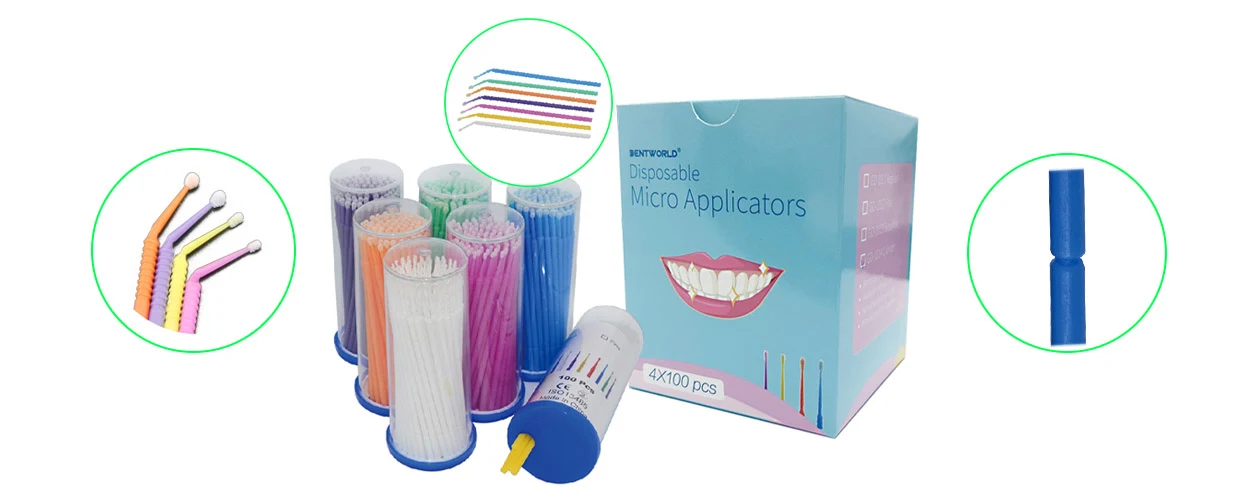The Micro Applicator Brush is a microfluidic controlled, precise and flexible applicator. It is widely used in medical, dental, personal care, cosmetic and other fields. In this article, we will introduce Micro Applicator Brush from multiple dimensions.
1. The Basic Definition of Micro Applicator Brush
A micro applicator brush is small, slender and commonly used tools. It is usually composed of a soft brush head and a plastic rod body. The brush head is made of soft fiber materials such as polyester and nylon, and can precisely apply to specific areas. The shaft body is usually made of plastic, with a moderate length and weight to ensure the flexibility and comfort of operation. Disposable application sticks are discarded after use and can effectively prevent cross-infection problems. Therefore, they are widely used in places with high hygiene requirements, such as medical, dental and beauty care.
2. Micro Applicator Brush Structure
The structure of disposable applicator brush mainly consists of two parts:
- Brush head (head) : The brush head part is the core component of the disposable applicator brush, usually made of synthetic chemical fibers (such as nylon, polyester, polyurethane, etc.), and has good flexibility and adsorption. The tiny brush head can be used for local medication application, wound cleaning, eye care, etc. To meet different needs, the applicator brushes are classified into various models based on the density and length of the bristles. You can choose according to your specific requirements to ensure that the medicine or treatment agent can be evenly applied to the target area. Some high-end models adopt a 50μm grade ultrafine fiber matrix (with a density of 2000 fibers per cm²) to achieve precise control of 0.01ml of drug.
- The stem (handle) : The stem is usually made of medical-grade polypropylene to ensure its lightness and sturdiness. In terms of the design of the rod body, anti-slip textures will be added to enhance the stability of operation. The upper part of the rod end can be bent to adapt to the complex environment of the oral cavity, and the lower part can be broken to adjust the length.

Micro Applicator Brush VS Cotton Swab:
| Product | Cotton Swab | Micro Applicator Brush |
| Coating Precision | ±1.2mm | ±0.05mm |
| Min-Drug Carrying Capacity | 0.1ml | 0.01ml |
| Material Utilization | 38±5% | 89±3% |
3. Application Areas of Micro Applicator Brush
Medical field:
As a precise drug delivery tool, micro applicator brushes are of great value in clinical practice. Its aseptic design allows precise implementation of wound care, wound disinfection and eye/ear canal drug dispensing operations, effectively avoiding cross-contamination of drugs. While realizing drug dosage control, in line with the requirements of prevention and control in modern medical care.
Dental application:
In oral treatment, the micro applicator brush is mainly used in fluoride coating, antibacterial gel administration and periodontal treatment. Its slender handle design makes it easy for you to complete delicate operations such as tooth surface treatment and gingival margin drug delivery in the restricted oral space. Which significantly improves treatment efficiency and patient comfort.
Beauty field:
In the field of fine beauty make-up, this product can realize millimeter-level make-up operations such as eyeliner outlining and lip modification. The gradient elasticity of the flocking head design can ensure the uniform extension of cosmetics. But also to avoid mechanical stimulation of sensitive areas. In the skin care field, it can accurately control the amount of mask essence and eye care solution applied and reduce product waste.
Tattoo industry:
The micro applicator brush plays an important role in the whole tattoo process: it is used to sterilize the local skin before the operation, to apply antibacterial ointment during the operation, and to precisely administer the restorative cream after the operation. Its microdosing properties maintain a moist environment on the traumatized surface, promoting epidermal regeneration and pigmentation. Compared with traditional finger application, it can reduce the coefficient of friction of the trauma by more than 60%. Together with the disposable aseptic packaging, it ensures that the tool is clean and sterile every time it is used, which improves the hygiene standard.
Experimental research:
In biological laboratory scenarios, the gamma-sterilized micro applicator brush is suitable for operations such as micro-reagent spotting, agar plate spreading and strain transfer. Its polyester fiber brush head has low protein adsorption characteristics, which ensures the reliability of cell culture experiments, and demonstrates unique technical advantages in PCR sample preparation, tissue section staining and other processes.
Pet medical care:
For companion animals such as dogs and cats, its soft brush head design can effectively prevent accidental damage to the ear canal/cornea, and with the improved palatability of the ointment base, it significantly reduces the stress reaction of the animal during treatment, which has been increasingly widely used in the treatment of fungal dermatoses, ear mites and other scenarios.

4. Micro Applicator Brush Market Trend Analysis
The global micro applicator brush market is witnessing structured growth, driven by the continuous rise in public hygiene awareness, overlaid with the strengthening of aseptic practices in the medical/medical aesthetic sector. The core trends are manifested as:
Sustainable Material Innovation
- The utilization rate of degradable materials reached 24% (data from 2023), and the production capacity of bio-based PLA/PHA composites increased by 300% over the past three years
- Production process iteration: Injection molding energy consumption is reduced by 35%, and the coverage rate of the water circulation system is increased to 78%
- The market share of EU EN 13432 certified products has exceeded 41%
Medical Grade Compliance Upgrade
- The sterilization standard has shifted to a dual certification system of EO ethylene oxide and gamma rays
- Biocompatibility testing has added ISO 10993-5 cytotoxicity and ISO 10993-10 allergenicity risk assessment
- The damage rate of aseptic packaging for medical products in 2024 should be ≤0.3%
Scene Customization Explosion
- Morphological adaptability design: Patented models such as 0.8mm conical brush heads for ophthalmology and 15° curved handles for dentistry account for 37%
- Innovation in drug carriers: Thermosensitive hydrogel coatings (responding to phase transitions at 32-37 ° C) account for 52% of the dental customization market
- Functional coatings: The growth rate of silver-loaded antibacterial products has reached a CAGR of 29%
Core Technology Breakthroughs
- The R&D intensity of leading enterprises is 9.2% : The focus is on nano-scale drug sustained-release coatings (controlled-release accuracy ±5μg) and ultrafine fiber matrices (porosity 92%±3%)
- In 2024, the number of patent authorizations of the TOP5 manufacturers increased by 67% year-on-year, among which 3D printing one-piece molding technology accounted for 38%
The Global Layout Accelerates
- Emerging market drivers: The CAGR in the Asia-Pacific region is 18.7% (2025-2030), with demand in ASEAN countries such as Indonesia and Vietnam surging by 42%
- Supply chain restructuring: The local productivity of North American manufacturers has increased to 61%, and the cost of sea transportation has dropped by 19%.

5. Teach You How to Choose Micro Applicator Brush
When choosing disposable micro applicator brush, the following core indicators can be referred to:
- Material and structural compatibility: Select appropriate materials and designs based on the intended use. For instance, if you are a dental clinic, you can choose a brush head that can be bent and a rod that can be broken to adjust its length. It can better adapt to the narrow and complex environment inside the mouth. For beauty or makeup purposes, soft bristles with stronger adhesion are more important.
- Hygiene requirements: Medical-grade products must meet the ISO 11135 ethylene oxide sterilization or ISO 11137 irradiation sterilization standards, with a sterility assurance level of SAL≤10⁻⁶, a biological load test report (initial contamination bacteria ≤100 CFU/g), and cytotoxicity tests that comply with ISO 10993-5 Class 2 contact requirements.
- Certification and Compliance: Ensure that the coating stick complies with ISO 13485, FDA, CE or your local certification requirements. These certifications can ensure the compliance of products in terms of quality, hygiene, safety and other aspects.
- Packaging and Storage: Primary packaging: Medical dialysis paper/plastic composite film (conforming to ISO 11607 sealing integrity test), secondary protection: tamper proof designed HDPE tank (passing ISTA 2A transportation test), storage conditions: Clean area with temperature of 10-30℃ and humidity of ≤65%RH.
6. Conclusion
Disposable micro applicator brush have formed a cross-field application matrix: in the medical field, they meet the drug administration needs of Class I/II wounds; in the medical aesthetics industry, they are suitable for the precise application of micro-drop drug solutions, and have been extended to scenarios such as laboratory sample preparation. According to the Grand View Research 2023 report, the annual growth rate of global market segmentation scenarios reached 7.2%-14.5%. Driven by the continuous improvement of the public’s requirements for hygiene, safety and environmental protection, the design of coating rods is also constantly innovating. The current iteration direction focuses on: degradable PLA composite materials, low-allergenic silicone brush heads (USP Class VI certified), and antibacterial coating technology (silver ion load ≥0.5μg/cm²). In the future, with the development of technology and changes in consumer demands, disposable micro applicator brushes will undergo more improvements and innovations, becoming more convenient, safe and environmentally friendly tools.


